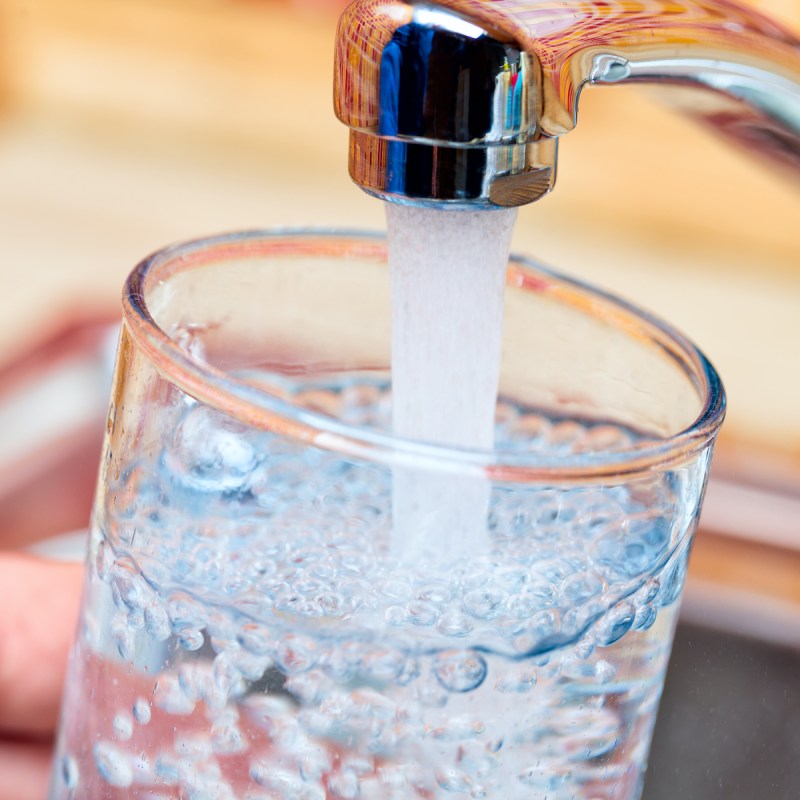
Note: The Travel Awaits team regularly updates content to provide the latest, and most accurate information to our readers. The updated content in this article may not reflect the views or opinions of the original author.
Videos by TravelAwaits
When you tell people you’ll be traveling to a foreign country, they will inevitably ask a variation of the question, “Is it safe to drink the tap water there?”
For that matter, you may even be asking the same question about drinkable tap water yourself.
Rather than trusting hearsay reports from other travelers or the results of a hasty web search, the safest way to learn about the tap water quality in countries you plan to visit is by relying on drinkable tap water reports from the Centers for Disease Control and Prevention (CDC).
You can find the CDC’s advice for traveling to every country in the world by first visiting its Destinations webpage, found here. After selecting the country you plan to visit, you can find the CDC’s drinking tap water quality recommendations for that country in the “Stay Healthy and Safe” section of that country’s profile.
To find out which countries have acceptable drinking tap water quality for tourists, and which countries don’t, we checked every country’s listing in the CDC’s Destinations list. The list below was accurate as of October 1, 2022.
Keep reading to learn where it is safe, and where it isn’t safe, to drink tap water in places all around the world.
Countries Where You Can Drink Tap Water (CDC List)
The CDC offers the same advice for every country where it is safe to drink the water.
“Food and water standards [here] are similar to those in the United States. Most travelers do not need to take special food or water precautions beyond what they normally do at home,” the CDC explains. “However, travelers visiting rural or remote areas that are served by unregulated water sources such as private wells should take special precautions to ensure the safety of their drinking water.”
Here is a list of the CDC’s recommendations for countries where it is safe to drink tap water:
- Aruba
- Australia
- Austria
- Bahrain
- Belgium
- Bermuda
- Canada
- Chile
- Cook Islands (New Zealand)
- Costa Rica
- Croatia
- Curaçao
- Czech Republic
- Denmark
- Dubai
- England
- Estonia
- Finland
- France
- Germany
- Greece
- Greenland (Denmark)
- Guadeloupe
- Hungary
- Iceland
- Ireland
- Isle of Man (UK)
- Israel (including the West Bank and Gaza)
- Italy
- Japan
- Kuwait
- Liechtenstein
- Luxembourg
- Malta
- Martinique (France)
- Monaco
- The Netherlands
- New Caledonia (France)
- New Zealand
- Northern Ireland (UK)
- Norway
- Palau
- Poland
- Portugal
- Puerto Rico
- Réunion (France)
- Saint Helena (UK)
- San Marino
- Saudi Arabia
- Scotland
- Singapore
- Slovakia
- Slovenia
- South Korea
- Spain
- Sweden
- Switzerland
- United Arab Emirates
- United Kingdom
- United States
- U.S. Virgin Islands
- Wales
Countries Where It Is Not Safe To Drink The Water
The flip side of the coin is that water in some countries is not safe to drink. The CDC offers the same warning for travelers visiting any of those countries.
“Unclean food and water can cause travelers’ diarrhea and other diseases,” the CDC explains. “Reduce your risk by sticking to safe food and water habits.”
To reduce the risk of illness while traveling in a country where the water isn’t safe to drink, the CDC cautions travelers to only drink bottled water with a sealed cap or water that has been disinfected. Travelers also should only use ice made with bottled or disinfected water. And, of course, those travelers should avoid tap or well water, as well as ice made with tap or well water.
Here is a list of the CDC’s recommendations for countries where it is not safe to drink tap water:
- Afghanistan
- Albania
- Algeria
- American Samoa
- Angola
- Anguilla (UK)
- Antigua and Barbuda
- Argentina
- Armenia
- Azerbaijan
- Azores
- The Bahamas
- Bangladesh
- Barbados
- Belarus
- Belize
- Benin
- Bhutan
- Bolivia
- Bonaire
- Bosnia and Herzegovina
- Botswana
- Brazil
- British Indian Ocean Territory
- Brunei
- Bulgaria
- Burkina Faso
- Burma (Myanmar)
- Burundi
- Cambodia
- Cameroon
- Canary Islands (Spain)
- Cape Verde
- Cayman Islands
- Central African Republic
- Chad
- China
- Christmas Island (Australia)
- Cocos (Keeling) Islands (Australia)
- Colombia
- Comoros
- Republic of the Congo
- Côte d’Ivoire (Ivory Coast)
- Cuba
- Cyprus
- Democratic Republic of the Congo
- Djibouti
- Dominica
- Dominican Republic
- Easter Island (Chile)
- Ecuador (including the Galápagos Islands)
- Egypt
- El Salvador
- Equatorial Guinea
- Eritrea
- Eswatini (Swaziland)
- Ethiopia
- Falkland Islands
- Faroe Islands (Denmark)
- Fiji
- French Guiana (France)
- French Polynesia (including the island groups of Society Islands: Tahiti, Moorea, and Bora-Bora)
- Gabon
- The Gambia
- Georgia
- Ghana
- Gibraltar (UK)
- Grenada
- Guam (U.S.)
- Guatemala
- Guinea
- Guinea-Bissau
- Guyana
- Haiti
- Honduras
- Hong Kong
- India
- Indonesia
- Iran
- Iraq
- Jamaica
- Kazakhstan
- Kenya
- Kiribati (formerly Gilbert Islands)
- Kosovo
- Kyrgyzstan
- Laos
- Latvia
- Lebanon
- Lesotho
- Liberia
- Libya
- Lithuania
- Macau
- Madagascar
- Madeira Islands (Portugal)
- Malawi
- Malaysia
- Maldives
- Mali
- Marshall Islands
- Mauritania
- Mauritius
- Mayotte (France)
- Mexico
- The Federated States of Micronesia (Including Yap Islands, Pohnpei, Chuuk, and Kosrae)
- Moldova
- Mongolia
- Montenegro
- Montserrat (UK)
- Morocco
- Mozambique
- Namibia
- Nauru
- Nepal
- Nicaragua
- Niger
- Nigeria
- Niue (New Zealand)
- Norfolk Island (Australia)
- North Korea
- North Macedonia
- Oman
- Pakistan
- Panama
- Papua New Guinea
- Paraguay
- Peru
- Philippines
- Pitcairn Islands (UK)
- Qatar
- Romania
- Russia
- Rwanda
- Saba
- Saint Barthelemy
- Saint Kitts and Nevis
- Saint Lucia
- Saint Martin
- Saint Pierre and Miquelon (France)
- Saint Vincent and the Grenadines
- Samoa
- São Tomé and Príncipe
- Senegal
- Serbia
- Seychelles
- Sierra Leone
- Sint Eustatius
- Sint Maarten
- Solomon Islands
- Somalia
- South Africa
- South Georgia and the South Sandwich Islands (UK)
- South Sudan
- Sri Lanka
- Sudan
- Suriname
- Syria
- Tahiti (French Polynesia)
- Taiwan
- Tajikistan
- Thailand
- Timor-Leste (East Timor)
- Togo
- Tokelau (New Zealand)
- Tonga
- Trinidad and Tobago
- Tunisia
- Türkiye (formerly Turkey)
- Turkmenistan
- Turks and Caicos Islands (UK)
- Tuvalu
- Uganda
- Ukraine
- Uruguay
- Uzbekistan
- Vanuatu
- Venezuela
- Vietnam
- British Virgin Islands
- Wake Island (U.S.)
- Yemen
- Zambia
- Zimbabwe
If you’re looking for more tips on how to stay safe and healthy while traveling, be sure to read our safety content.
Symptoms of Drinking Contaminated Tap Water
Factors such as your overall health, age, and physical condition will determine how you react when you drink tap water. The most commonly reported problems experienced from drinking impure tap water include gastrointestinal problems, diarrhea, nausea, stomach cramps and pains, and dehydration.
For that reason, always use best safety practices to stay healthy. Also, count on unexpected medical expenses that might result from water-borne illnesses. If you don’t want to risk being vulnerable to such unpleasantries, ensure you have an insurance plan designed for international travel.
It’s Not Just Drinking Water
There are plenty of other ways unsafe drinking water can affect you. Apart from just drinking water, ice cubes in your drinks made with the same untreated tap water are another thing to watch out for.
Also, the tap water used in restaurants to prepare your food may be untreated as well. Salads, soups, drinks, and more, can sometimes be the cause of an upset stomach, but that depends really on an individual’s immune system.
Other than in what you eat or drink, it’s advisable to be cautious in the shower. If you have concerns about the water quality, avoid gargling or swallowing the water while taking a shower or when you’re brushing your teeth. Use bottled water instead.
FAQs
Can Tap Water Make You Sick?
Yes, if you drink tap water that is contaminated with germs and chemicals at levels enough high to make you sick. The main symptom of drinking bad tap water involves gastrointestinal issues, like diarrhea, nausea, and stomach cramps.
Who Is Most Vulnerable to Tap Water?
Certain groups of people are more sensitive to contaminants. Children, babies, and fetuses have less blood volume than adults, and contaminants like heavy metals can have a greater effect on them. People with compromised immune systems may be more susceptible to bacteria and parasites from unsafe drinking water.
Can I Tell if Tap Water Is Safe to Drink?
Not exactly. According to the World Health Organization, you’re largely unable to determine the quality of tap water using your senses. If you want to drink tap water, drinkable tap water should ideally be clear without any odor or taste. Otherwise, it could signal the presence of unsafe contaminants.
Does Boiling Tap Water Make It Safe?
If you don’t have access to bottled water or drinkable tap water during your travel, the CDC recommends bringing tap water to a rolling boil for 1 minute and then allowing the water to cool before using it. Drinking water from the tap may otherwise be very dangerous.
What Is the Alternative to Tap Water While Traveling?
Bottled water is probably the best alternative for your travels. Bottled water is a better option in places where tap water is unsafe to drink. Also, if your accommodation has water filters, it doesn’t mean that the water is any safer as many water filters only improve the taste.
